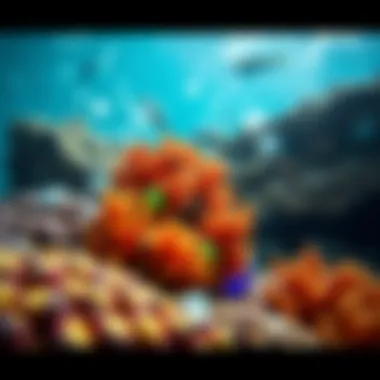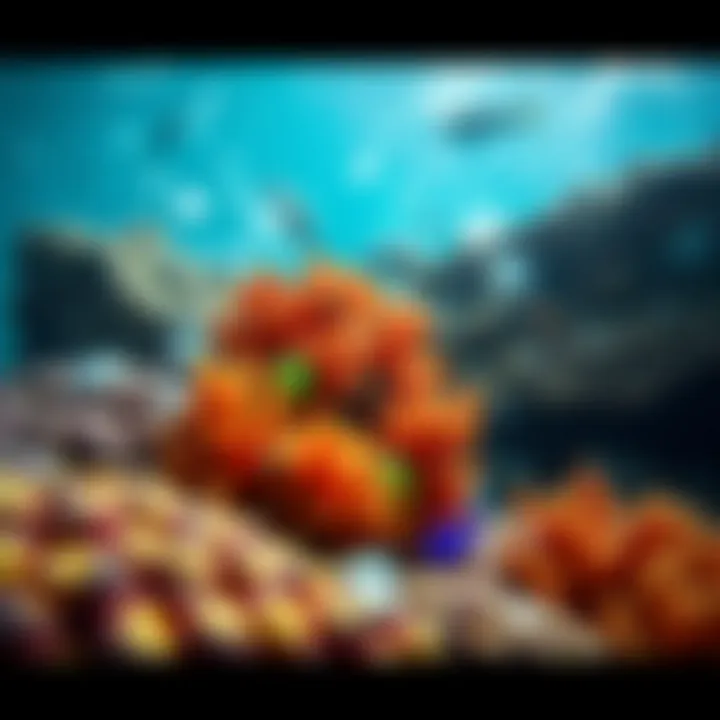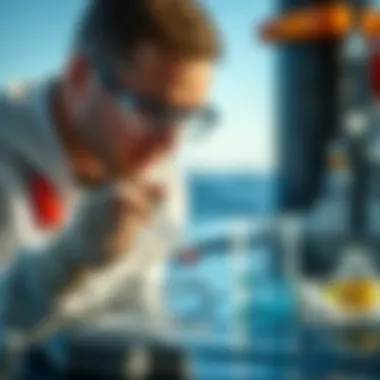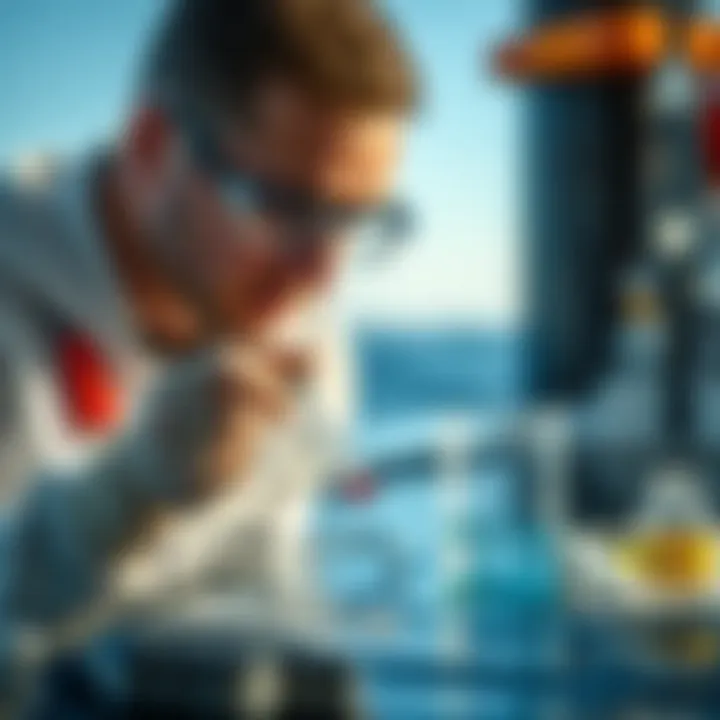Understanding Marine Pollution: Impacts and Solutions


Intro
Marine pollution is a growing concern in the contemporary world. As our oceans become increasingly tainted by human activity, the ramifications ripple through ecosystems and human health alike. From plastics choking marine life to chemicals leaching into waters, the variety of pollutants is vast and complex. In this article, we aim to shed light on this pressing issue. We will explore the numerous types of pollution, their sources, and their consequences. Moreover, we will look into community initiatives and regulatory measures that aim to address this crisis, particularly for those who enjoy watersports and seek to preserve these vital environments.
Understanding the challenges posed by marine pollution is not just for environmentalists. Athletes, coaches, and recreationalists have a stake in the health of our oceans. Preserving marine environments is crucial for sustaining the habitats of the species we engage with and the waters we enjoy. This knowledge empowers individuals to take meaningful action, whether that means supporting local movements or adopting best practices while out on the water.
By synthesizing the different facets of marine pollution, this article provides a comprehensive guide, emphasizing both the importance of awareness and the potential for positive change.
Prelude to Marine Pollution
Marine pollution is an ever-growing issue that affects the planet's delicate ecosystems. Understanding this topic is crucial not just for environmentalists but for anyone who enjoys the vast blue whether through recreation or simple appreciation. The marine environment, which covers more than 70% of the Earth's surface, is essential for sustaining life, regulating climate, and providing resources that we often take for granted.
Definition of Marine Pollution
Marine pollution refers to the introduction of harmful substances and organisms into the ocean—this includes anything from chemical runoff to plastic waste. It signifies a range of pollutants that degrade the quality of seawater and disrupt marine habitats. When referring to marine pollution, one may think of the plastic bottle floating in a beach, but it extends far beyond the visible debris. Pollution can manifest in various forms, including:
- Chemical Contaminants: These can arise from industries discharging waste into waters without proper treatment.
- Plastic Pollution: Billions of tons of plastic, which take years to decompose, contaminate our oceans.
- Oil Spills: Large-scale disasters that cause immediate and dire effects on marine life.
- Nutrient Pollution: Excess fertilizers washing into the ocean, leading to algal blooms that can be toxic.
Importance of Addressing Marine Pollution
Now more than ever, tackling marine pollution demands our unwavering attention. The consequences are not merely ecological; they ripple through economies and seep into our health. Recognizing the significance of this issue brings multiple benefits:
- Protecting Biodiversity: Marine ecosystems are home to countless species. Healthy oceans foster diverse life, essential for ecological balance.
- Safeguarding Human Health: Polluted waters can lead to health risks for those who rely on seafood for nutrition or those involved in recreational activities.
- Boosting Local Economies: Clean seas attract tourism and support fishing industries, which are vital for many communities around the world.
"The sea, once it casts its spell, holds one in its net of wonder forever." – Jacques Cousteau
Types of Marine Pollutants
Understanding the different types of marine pollutants is crucial to tackling the broader issue of marine pollution. With each kind of pollutant having distinct characteristics, sources, and effects, comprehending these elements can better inform responses and mitigation strategies. Awareness of these pollutants can empower watersports enthusiasts, environmental advocates, and policymakers to collaborate on effective solutions.
Plastic Pollution
Plastic pollution has reached a crisis level in our oceans, affecting everything from the smallest plankton to the largest marine mammals. This type of pollution stems from everyday products that people often discard carelessly. As plastics degrade slowly, they pose long-term threats.
- Sources: Plastics enter oceans via litter, storm drains, and waste mismanagement. Even distant landlocked areas can contribute to plastic pollution through rivers.
- Effects: Marine animals can ingest plastic debris, mistaking it for food. This ingestion can lead to death or serious health complications. Moreover, microplastics have infiltrated the food chain, raising concerns for human health.
Chemical Contaminants
The ocean often plays host to a variety of chemical contaminants, which come from industrial activities, agricultural practices, and even household products. Chemicals like heavy metals, pesticides, and pharmaceuticals find their way into marine environments through runoff and direct discharges.
- Sources: These pollutants can originate from factories, farms, and even improper disposal from households.
- Effects: Chemical pollutants can be toxic to marine organisms, leading to reproductive issues and disruptions in development. Some chemicals bioaccumulate in the food web, affecting species higher up, including those that humans rely on for food.
Nutrient Pollution
Nutrient pollution primarily arises from excessive nitrogen and phosphorus entering marine ecosystems, often due to fertilizers or sewage. This influx of nutrients can trigger harmful algal blooms that severely disrupt marine ecosystems.
- Sources: Agricultural runoff, waste discharge from cities, and even certain stormwater practices contribute significantly to nutrient loading in coastal areas.
- Effects: Algal blooms can deplete oxygen in the water and produce toxins harmful to marine life and humans alike. Fish kills are common, and entire marine ecosystems can be thrown into disarray when nutrient imbalances occur.
Oil Spills
Oil spills are catastrophic events that can wreak havoc on marine environments. Whether caused by offshore drilling accidents or shipwrecks, the impact of an oil spill can last for decades.
- Sources: Major oil spills usually occur during transportation of oil, either via pipes or ships, but they can also originate from offshore drilling operations.
- Effects: Oil coats everything, hindering the marine life’s ability to breathe and insulating birds and mammals from the cold. The aftermath can devastate local economies reliant on fishing and tourism.
Microbial Pollution


Microbial pollution, often a less-discussed issue, refers to the contamination of marine environments by pathogens. These organisms can enter the ocean from various sources, including untreated sewage and runoff from the land.
- Sources: Urban runoff, septic systems, and even agricultural processes can introduce harmful microbes into marine environments.
- Effects: Pathogens can lead to diseases in aquatic organisms as well as humans. Contaminated water can restrict swimming, fishing, and recreational activities, often requiring costly clean-up efforts.
Causes of Marine Pollution
Understanding the causes of marine pollution is crucial for both awareness and action. By identifying these root issues, individuals and communities can take tangible steps to mitigate their impact. The marine environment is under siege from a multitude of sources, each contributing to a complicated web of pollution. This section will delve into specific causes, highlighting their implications and offering insights essential for athletes, coaches, and recreationists who rely on these waters for their activities.
Industrial Waste Discharges
Industrial facilities discharge a staggering amount of waste into our oceans every year. This can include heavy metals, solvents, and other harmful substances that can devastate marine ecosystems. In many cases, factories located near coastlines release untreated wastewater directly into the sea, under the guise of complying with lax regulations or simply due to negligence. As a result, fish and other marine creatures can accumulate these toxins in their bodies, affecting not only their survival but also those who consume them.
Moreover, the impact on biodiversity can have a ripple effect on coastal economies, particularly in communities dependent on fishing and tourism.
Agricultural Runoff
Farming practices contribute substantially to marine pollution, primarily through the runoff of fertilizers and pesticides. During rainstorms, these chemicals can wash into nearby rivers and eventually flow into the ocean. This nutrient influx can lead to algal blooms, which block sunlight from reaching submerged plant life, and when these blooms die off, the decomposition process consumes oxygen in the water, creating dead zones.
Athletes who rely on clean waters for swimming and other sports may find these areas increasingly hazardous due to low oxygen levels and harmful algal toxins. Understanding the sources of agricultural runoff can empower individuals to advocate for sustainable farming practices that reduce chemical application and protect aquatic environments.
Urban Development
As cities expand, the resulting impervious surfaces—like asphalt and concrete—drain rainwater rapidly into local waterways, often carrying pollutants such as oil, metals, and trash. Urban runoff is a significant contributor to marine pollution, as it consolidates numerous contaminants from urban settings before dumping them into the ocean. This can severely degrade water quality, impacting recreational activities and marine life. A comprehensive urban planning approach that includes green infrastructure and sustainable drainage systems can help mitigate this issue.
Maritime Traffic
The movement of vessels—whether for commercial shipping or recreational boating—poses another significant threat to marine environments. Fuel spills, ballast water discharge, and even the physical impact of ships on marine habitats can lead to long-lasting damage. Coastal areas that are frequented by water sports enthusiasts often bear the brunt of this traffic. Education on the impacts of vessel waste, along with stricter regulations, can aid in minimizing these harmfull effects.
Climate Change Effects
The overarching concern of climate change casts a long shadow over marine health. Rising ocean temperatures can create more frequent and severe marine heatwaves, leading to coral bleaching and diminished fish populations. Additionally, ocean acidification—a direct consequence of increased CO2 levels—can weaken shellfish and disrupt the food chain. For athletes and recreational users, these changes compromise the very ecosystems they thrive in. It’s essential to recognize climate change not only as an environmental issue but as a social and economic one, benefiting from comprehensive action against it can encourage healthier oceans.
"Protecting our oceans is not just an environmental obligation but a social responsibility to the future generations."
By understanding these causes of marine pollution, stakeholders across all sectors—be it athletes, local businesses, or regulatory bodies—can engage in meaningful dialogue and action aimed at the restoration and protection of marine environments.
This knowledge equips each of us with the tools to push for policy changes, promote sustainable practices, and take individual actions that contribute to a cleaner, healthier ocean.
Consequences of Marine Pollution
Understanding the consequences of marine pollution is essential as they not only affect the aquatic environment but also have far-reaching repercussions for humanity. The interconnectedness of marine ecosystems and human health emphasizes the need for awareness and action. When we talk about marine pollution, we're not just discussing the health of fish or coral reefs; we're touching on issues that directly influence our daily lives, our economies, and the very fabric of society.
Impact on Marine Life
Marine life is undeniably at the frontline of the battle against pollution. From the majestic blue whale to the tiniest plankton, all creatures are harmed in one way or another due to pollutants. For instance, plastic waste can choke marine animals, while chemical contaminants can disrupt biological processes and lead to diseases. These pollutants can accumulate in the food chain, adversely affecting even the apex predators, including humans.
The alarming statistic is that a staggering 1 million marine creatures are killed each year, which serves as a sobering reminder of the tangible impact pollution has on biodiversity. Coral reefs, often dubbed the "rainforests of the sea," are greatly affected by nutrient pollution, which leads to harmful algal blooms. Such disruption not only devastates marine species but also erodes the very habitat on which they depend.
Effects on Human Health
The link between marine pollution and human health is stark and critical. Contaminated seafood poses direct health risks. When heavy metals, like mercury, seep into the ocean, they can bioaccumulate in fish. Consuming these fish can lead to neurological disorders, digestive issues, and various diseases. Moreover, people engaging in watersports without awareness of pollution may expose themselves to harmful toxins.
Additionally, when pollutants enter the water cycle, as they often do, it can lead to drinking water contamination, which poses yet another risk to human health. According to the World Health Organization, polluted water can transmit diseases like cholera and hepatitis. Thus, marine pollution indirectly jeopardizes the health of communities relying on marine resources.
Economic Repercussions
Beyond environmental and health implications, marine pollution has profound economic consequences. The fishing and tourism industries, vital for many coastal communities, are significantly impacted by pollution. Declining fish stocks caused by habitat degradation and pollution can lead to decreased catches, affecting livelihoods.


Similarly, tourism can take a hit when pristine beach environments become littered with debris or algae blooms turn beautiful coastlines toxic. Coastal nations spend billions annually to clean and protect their marine spaces, diverting funds from other critical areas.
In summary, understanding the consequences of marine pollution is crucial for anyone engaged in marine activities—from athletes to coaches and recreationists. When the marine environment suffers, its effects ripple outwards, affecting not just the ocean but our very way of life. Awareness, responsibility, and action are imperative for the health of marine ecosystems and humanity alike.
Community and Global Responses
Addressing the issue of marine pollution necessitates a unified front, comprising both community-led initiatives and international efforts. This section explores how grassroots movements, global treaties, and corporate accountability contribute to mitigating marine pollution. Removing pollution from our waters cannot solely rely on governmental action; it demands a concerted effort from all stakeholders involved.
Grassroots Initiatives
Grassroots movements have increasingly emerged as powerful forces for change in combatting marine pollution. Local communities, concerned citizens, and enthusiastic volunteers often band together to spearhead clean-up drives, educational programs, and awareness campaigns. For instance, organizations like Ocean Conservancy and Surfrider Foundation mobilize volunteers to clear beaches and raise awareness about the harms of plastics and litter.
These initiatives not only help in cleaning up beaches but also foster a spirit of community responsibility. They connect people with their local waterways, urging them to consider the impact of their everyday habits. Municipalities often partner with these grassroots efforts to provide resources, creating a synergy that amplifies their effects.
The benefits of grassroots initiatives are multifaceted:
- Local Engagement: Community members developing a bond with their environment typically feel more compelled to protect it.
- Empowered Advocacy: Individuals educated about pollution can become passionate advocates, influencing local policies.
- Innovation: Local movements tend to find creative solutions to unique environmental challenges through hands-on experience.
International Treaties and Agreements
At a global scale, treaties and agreements play a crucial role in curbing marine pollution. One such prominent document is the United Nations Convention on the Law of the Sea (UNCLOS), which establishes guidelines for sustainable ocean resource management and protection. By uniting countries under shared regulations, this treaty holds members accountable for pollution that crosses borders.
Moreover, agreements like the Montreal Protocol highlight international cooperation in addressing pollutants. Originally targeting ozone-depleting substances, its model showcases how flexible agreements can adapt to various environmental challenges, including marine pollution.
Some vital points regarding international treaties include:
- Standardization: These treaties create common ground for national laws, ensuring that all member states adhere to regulated practices.
- Funding and Technology Sharing: Countries often collaborate on funding research initiatives focused on finding innovative solutions to pollution.
- Global Awareness: International discussions around pollution bring media attention, heightening public awareness and education on a larger scale.
Corporate Responsibility
Finally, corporations also carry a hefty nod of responsibility. As major drivers of economic activity, their practices directly influence environmental health. Businesses involved in maritime activities, from shipping to fishing, must adopt sustainable practices that minimize their ecological footprint. Many companies are beginning to realize that a green reputation can be an attractive quality for consumers.
For instance, Unilever and Coca-Cola have made commitments to reduce their plastic waste, adopting policies to enhance recycling and sustainable sourcing. Corporate responsibility in marine pollution encompasses:
- Sustainable Practices: Companies are increasingly investing in clean technology and eco-friendly materials.
- Transparency and Accountability: Organizations are held to higher standards when they publish sustainability reports detailing their environmental impact.
- Community Involvement: Many corporations sponsor local initiatives, contributing their resources to support cleanup efforts.
A collective and multifaceted approach, combining grassroots initiatives, international regulation, and corporate accountability, is essential to combat marine pollution effectively.
The connected efforts from various sectors can create a formidable defense against the pollution that threatens our seas. By promoting awareness, sharing knowledge, and taking concrete actions, all parties can contribute to a cleaner, healthier marine ecosystem.
Mitigation and Prevention Strategies
Mitigation and prevention strategies form the backbone of any meaningful effort to combat marine pollution. By understanding these strategies, stakeholders—including government officials, businesses, and local communities—can make informed decisions that not only address current issues but also pave the way for more sustainable practices. Given the complex nature of marine pollution, approaches require a multifaceted lens that involves cutting-edge technology, community involvement, and legislative changes. This section delves deep into strategies that can help protect our oceans, emphasizing their relevance and feasibility.
Reducing Plastic Use
Plastic pollution is often considered the poster child of marine pollution, given its sheer volume and persistence in the environment. Reducing plastic use isn’t merely about cutting down straws and bags; it demands a multi-pronged approach. One effective method is to emphasize alternatives to single-use plastics. Materials like bamboo, glass, and metal can replace disposable items.
- Engaging the community through local clean-up events can also raise awareness.
- Education on recycling teaches individuals how to dispose of plastics properly.
By instilling a culture of reduction, society can significantly ease the burden of plastic on marine ecosystems. Think of it as passing the baton of responsibility; when one individual chooses a reusable bag over plastic, it creates ripples that can inspire others to follow suit.
Innovative Waste Management Solutions
Until society can eliminate plastic usage entirely, effective waste management remains crucial. Innovative waste management solutions such as waste-to-energy programs and advanced recycling technologies show immense promise. In cities like San Francisco, for example, trash pickers sift through waste with precision recovery methods, ensuring that maximum recyclables are processed correctly.
- Biodegradable materials are being developed that break down more quickly in marine environments.
- Advanced sorting technology ensures that recyclable materials do not end up in the ocean.


These solutions not only reduce the initial volume of waste but also lessen the toxic residues that may leach into our oceans, thereby promoting healthier marine life.
Legislation and Policy Changes
Legislation plays a pivotal role in the mitigation of marine pollution. Policies that restrict the production and distribution of non-biodegradable materials can have lasting impacts. For instance, the European Union's directives on single-use plastics illustrate how legislative measures can drastically alter consumption patterns. Beyond bans, regulations that require industries to report their waste can also help enhance transparency.
Investing in policy reforms—such as subsidizing companies that implement sustainable practices—encourages more businesses to jump on the bandwagon. This not only reduces pollution at the source but also stimulates economic growth in green sectors. Thus, where there is legislative will, there's a way to turn the tide against environmental degradation.
Community Engagement and Education
Communities are the lifeblood of any successful campaign against marine pollution. Grassroots efforts often yield the most effective results. Local groups can implement education programs to inform residents about the impacts of pollution and the importance of preservation. Events like beach clean-ups and workshops can unite communities around a common cause.
- Schools can incorporate marine education into their curriculums.
- Social media platforms, like Facebook or Reddit, can be utilized to rally support and spread the word.
When communities come together, they forge not just a better understanding of marine environments but also a collective determination to protect them.
"It is not enough to stare up the sky; we must act to change it." - Unknown
The Role of Technology in Combatting Marine Pollution
The call to address marine pollution resonates louder today than ever. As awareness grows, so does the realization that technology holds significant potential in mitigating the impacts of this pressing issue. Within this conversation, we must explore various technologies that can assist in the cleanup, monitoring, and prevention of marine pollution. These tools not only enhance our efforts but also expand our understanding of pollutants and their ecological consequences.
Innovations in Clean-Up Technologies
In recent years, innovations in clean-up technologies have transformed how we address marine pollution. For instance, specialized drones and underwater robots, such as the Ocean Cleanup’s System 001, showcase how technology can be harnessed to collect plastic debris from the oceans efficiently. These machines can navigate complex marine environments and remove pollutants that lie far from the shore, where human efforts may be ineffective or near impossible.
Another focus has been on bioremediation technology. This involves using microorganisms to degrade pollutants in water. Researchers have developed synthetic biological systems to enhance the natural decomposition of harmful substances like oil spills and heavy metals. By introducing specific bacteria into the affected regions, we can watch as these microscopic workers break down contaminants, restoring the water to a healthier state.
- Self-Cleaning Technologies: Some companies are even developing self-cleaning surfaces that can repel oil or dirt at the molecular level, making it harder for these substances to adhere to equipment, boats, or nature itself. This not only reduces pollution but also minimizes wear and tear.
These innovations represent a beacon of hope amidst the ocean of challenges posed by pollution. More than mere tools, they signify a cultural shift toward leveraging knowledge and resources to safeguard our marine environments.
Monitoring and Data Collection
As crucial as clean-up efforts are, they must be backed by robust monitoring and data collection strategies to be truly effective. Without accurate data, any cleanup initiative risks being akin to dropping a pebble in the vast ocean with no way of knowing if it made a ripple.
Technologies such as satellite imagery and remote sensing play a vital role in this aspect. They can track pollution sources, assess the spread of oil spills, and analyze algal blooms in real-time. Organizations and local governments can utilize this data to make informed decisions on where to deploy cleanup efforts.
Wearable technology can also contribute to cleaner oceans. Devices such as smart buoys, which measure various water quality parameters like temperature, salinity, and contamination levels, continuously send back valuable data to researchers. This collection of information paints a clearer picture of the state of marine environments and equips stakeholders with the foundation needed to enact change.
- Crowdsourced Data: Additionally, the emergence of crowdsourced data platforms enables recreational fishermen and beachgoers to report sightings of pollution. This grassroots approach cultivates community involvement and allows for quicker responses to pollution incidents.
"Every byte of data collected contributes to a better understanding of our oceans. Ultimately, knowledge empowers action."
The integration of technology into marine pollution monitoring manifests as a vital strategy. We are not just fighting a battle; we’re assembling an arsenal of knowledge and tools that pushes us toward sustainable solutions.
Culmination
As we conclude our exploration of marine pollution, it becomes paramount to recognize the vast implications of this issue. Understanding the various pollutants that endanger marine ecosystems and humans alike is crucial. It’s not just a matter of statistics; this is about our ocean’s health and our planet's future.
Summary of Key Points
Throughout the article, we have dissected the types of marine pollutants, ranging from plastic waste to oil spills, each category presenting unique challenges. We’ve pinpointed causes such as industrial discharges and agricultural runoff that exacerbate these issues. The consequences are severe, affecting marine life, human health, and economic stability.
Engaging with community and global responses, we’ve seen initiatives rise to combat pollution. We discussed how technology plays an ever-growing role in monitoring and tackling this crisis. Each section underscores the critical need for awareness and action. In summary, marine pollution is a complex predicament, but it is one that collectively we can address through education, legislation, and innovative solutions.
Call to Action for Watersports Enthusiasts
For those who love to ride the waves or explore the depths, your role in preserving our oceans cannot be overstated. You stand as stewards of marine habitats. Here are some ways to get involved:
- Educate Yourself and Others: Share your knowledge about the effects of pollution with fellow enthusiasts.
- Participate in Clean-Up Events: Engage with local organizations focused on marine conservation.
- Promote Sustainable Practices: Use eco-friendly products and minimize waste during your activities.
- Advocate for Legislation: Encourage policies that aim to reduce pollution and protect marine environments.
- Connect with Others Online: Use platforms like reddit.com or facebook.com to raise awareness and share success stories.
By taking these steps, you help ensure that future generations can also enjoy and benefit from the beauty of marine environments. The ocean is a shared resource; it’s our responsibility to protect it, so let's roll up our sleeves and get to work.







